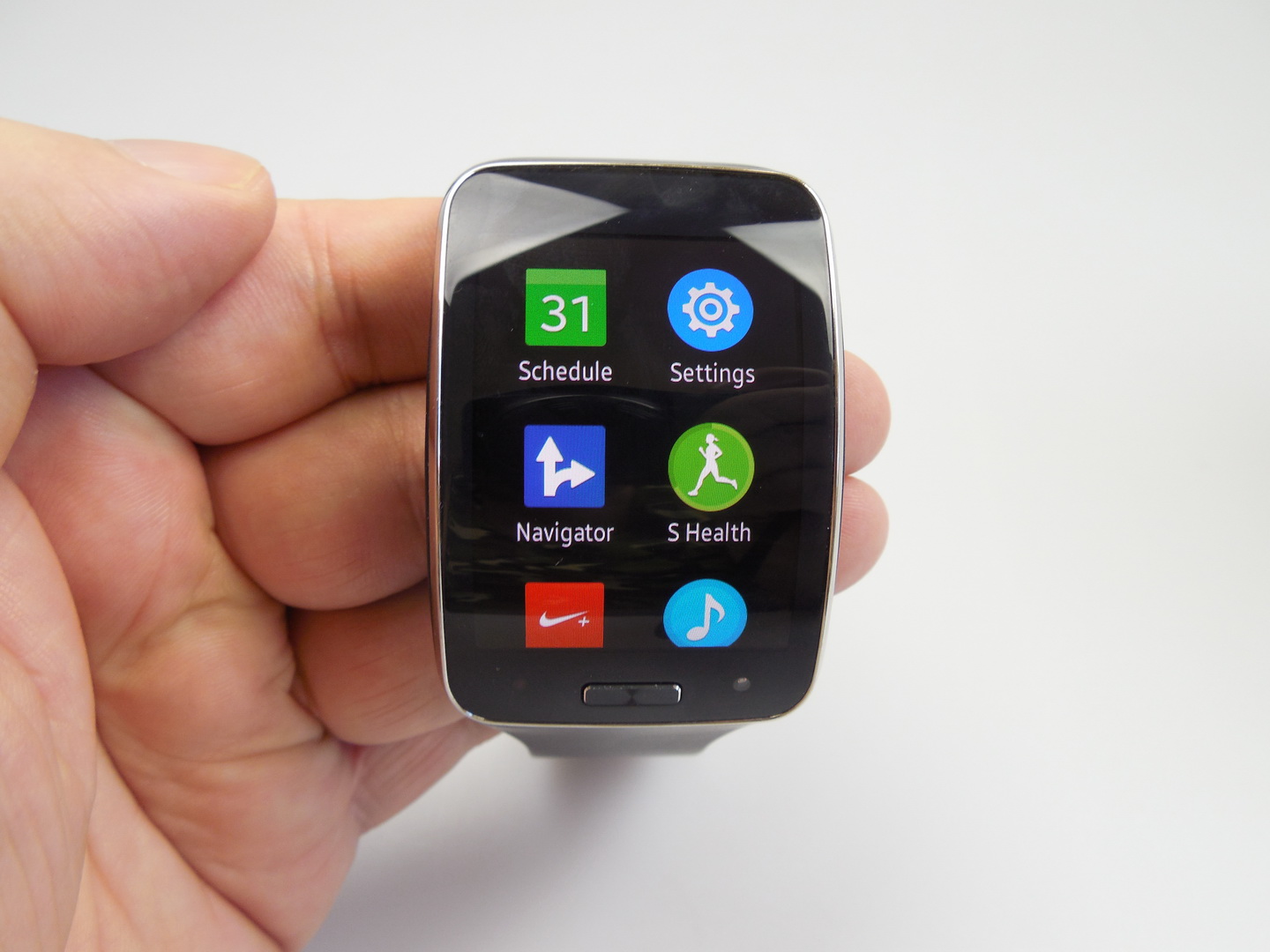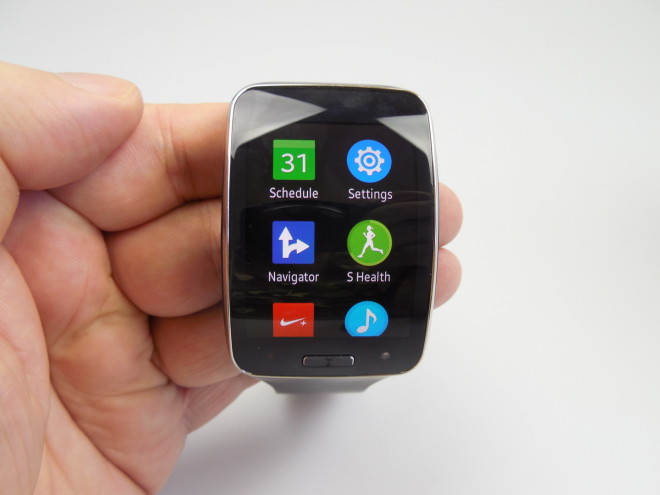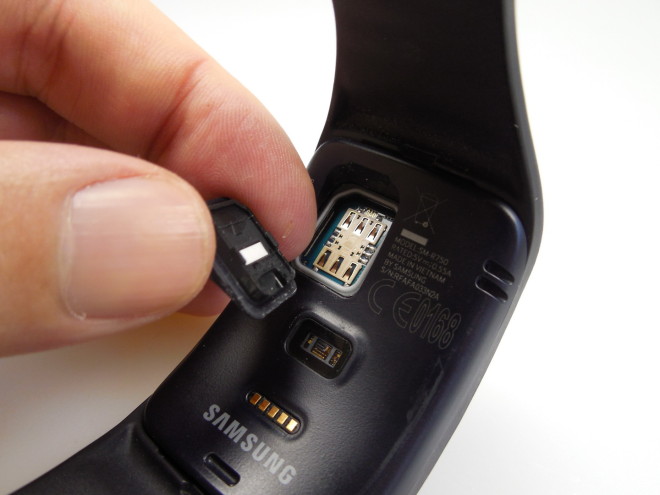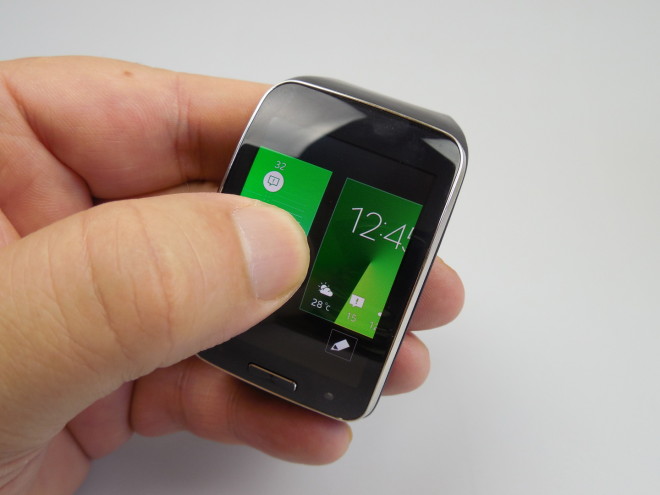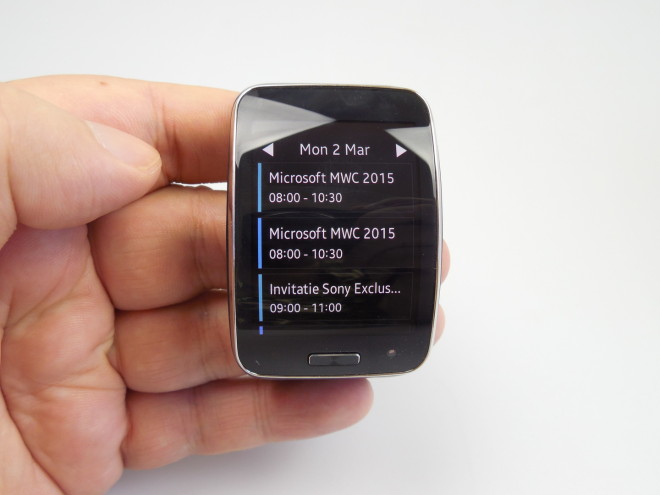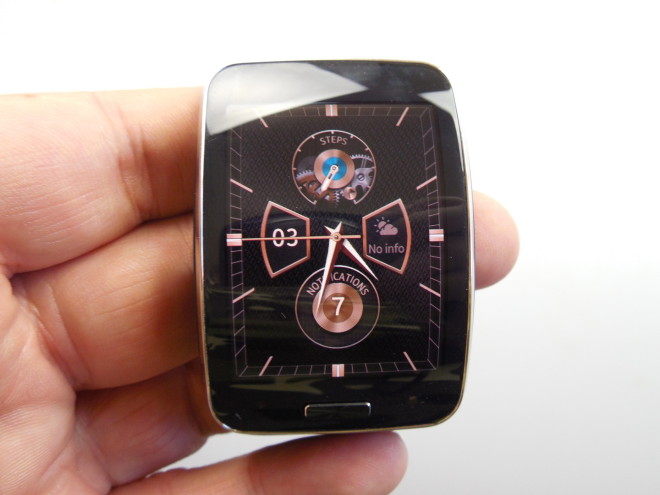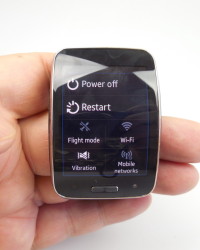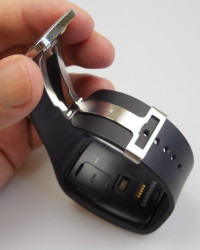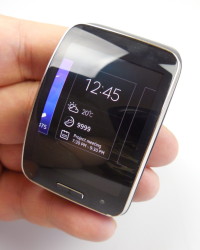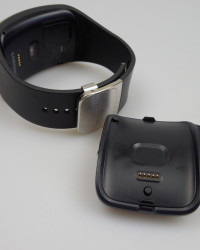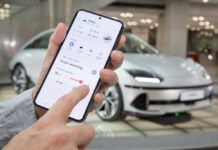Samsung Gear S is probably the best specced Samsung smartwatch and one of the best specced watches on the market. This model was announced in the summer of 2014 and launched in the fall. This is a smartwatch used as a phone and it works independently from the handset.
It’s priced at $350 on T-Mobile USA and it measures 12.5 mm in thickness. It weighs 67 grams, features a curved screen and it’s dust and water resistant, at up to 1 meter and 30 minutes. Gear S has a plastic body and comes bundled with a charging kit, that has an extra battery inside. We also had some extra straps for the watch, in red, blue and gray.
The clasp is user friendly, especially if you handled a Samsung watch before. This is a big and massive smartwatch, that’s also pretty light and it comes with a rubberized plastic band. Upfront there’s the screen with chromed edges, as well as a physical Home button. In the same area there are sensors, like the one for light and one for UV.
At the back we find speakers, a nano SIM card slot, that’s quite hard to prop open, unless you use long nails or a special tool. Also at the back there’s a heart rate sensor, charging pins and I have to mention that it’s quite hard to put on and remove the charging cradle. The watch is reasonably sturdy, but it’s quite big and its band will make you sweat.
You will certainly not go unnoticed if you wear this watch, that’s more of a mini phone. Still, it’s reasonably comfy. On the hardware side, we get a curved Super AMOLED 2 inch screen, with a 360 x 480 pixel resolution, as well as a dual core Snapdragon 400 CPU, clocked at 1 GHz. There are 512 MB of RAM inside, a microphone, 4 GB of storage and as far as connectivity goes, there’s Bluetooth 4.1, WiFi b/g/n, 3G, AGPS, Glonass and microUSB 2.0.
Sensors available here are the accelerometer, gyroscope, compass, heart rate sensor, ambient light sensor, UV one and the barometer. The battery inside the watch is a 300 mAh unit and the cradle brings an extra 350 mAh battery. On paper the main battery offers 24 hours of usage, but in my test I achieved one day and a half of usage. That happened with WiFi and Bluetooth on, about 30 minutes of fitness tracking, games and apps used for dozens of minutes and checking mail about 10 times, plus 2 or 3 calls.
The charging of the Gear S takes in total 2 hours and 20 minutes, with cradle included. The battery life is OK and you should know that a fitness session that’s a bit longer may drain as much as 30% of the battery. Now we analyze the audio, that’s crisp and reasonably loud, with the keyboards well heard in songs and a bit of distortion happening at maximum volume.
The bass is OK and you can control playback of tunes stored on the watch or tunes stored on the phone paired with the watch. The display offers excellent view angles, a bright and crisp experience, vivid colors and a great response to touch. The brightness can be set to automatic and you can change fonts, if you want to. The display offers deep blacks and there’s no problem with the viewing in full sunlight.
Contrast is perfect and the screen doesn’t get dirty easily, which is always a plus. Overall, the display is excellent for a watch. As far as the phone features go, we’ve got a crisp and loud experience, although a bit echoey. There’s no noise cancelling here and the signal sits at about 60%. Overall, the call experience is so-so, although the person on the other side said that they heard me perfectly.
The fitness features include a pedometer, with a chart that shows basically a graph of your performance. There are logs offered here, with details like steps, minutes, kilometers walked, calories used up and the goal (10.000 steps usually). You also get a healthy pace mechanism, that pushes you to 10 minutes of brisk walking per day. You even have an active time alert, an anti sedentary feature, that alerts you if one hour has passed without moving around.
You can create a profile or connect to the current S Health one synced from your phone, showing the weight, height and age. The Exercise section offers options like Run, Walk or Cycle, as well as Hike. Each of them comes with a chart, log (time, distance, calories, average speed, max speed, a map tracing your route), but I should mention it takes quite a while for the GPS to find you.
The Heart Rate section has its own logs and charts. The actual usage of the heart rate sensor isn’t very good, especially if you have arm hair. Also, the sensor isn’t very precise, giving different readings by tens of BPM even a few minutes apart. The nice thing is that you specify what you were doing when the pulse was taken, including resting, being sad or happy, or playing sports.
Among the features of this watch there’s the sleep monitoring, which I frankly didn’t test, because this watch is too big and expensive to sleep with to be honest and you’ll be moving around a lot, risking to damage it maybe. Finally, there’s the UV measurement feature, useful if you don’t want to get burnt at the seaside. We move on to the software, where Tizen OS greets us, with a TouchWiz styling.
There are a few homescreens offered here, including a main Watch Face, a music player homescreen, a fitness one, one for news, a Calendar one and Weather one. Basically, each homescreen shows a big widget. The controls may feel familiar if you’ve used a smartwatch before: you swipe towards the bottom in an app to close it, swipe to the bottom in a homescreen to go Home and swipe to the top to trigger options in an app.
You can also scroll through the news or playlist of songs using the same motion. Finally, swiping to the bottom on the main homescreen shows the Quick Settings, like brightness, Autoo, sound and more. The UI is fluid, the side swipes are key for your interaction and if you swipe up in the Watch Face homescreen you’ll view the app list. At the top of the app list screen rests the Recent Apps area, used for multitasking and allowing you to swipe apps to the side to close them, or close them all via the associated option.
Finally, in the main Homescreen you can swipe right to see the notifications and keep swiping to the right to view each notification in a more detailed way. Now we get to the apps, where I have to mention that a phone is required to install those apps. The preinstalled apps list includes Contacts, Email, Schedule and Settings, to start.
We focus on the Settings area for a bit, that includes the style of the watch face, wallpapers, color, theme and font (style and size), call functions (voice control included), Sound (vibrate, mute, volume, strength of vibration, ringtones). The display settings include Timeout, brightness, Wake up screen, while the Connections options involve pairing with a Bluetooth headset, WiFi, Flight Mode, Data Usage, GPS, notifications. There’s a Do Not Disturb Mode included and a variety of functions to associate with a double press of the physical Home button.
There’s a privacy lock with a PIN included, wake up gesture (raise to face and look), Mute/Pause if you put the hand on the screen and finally there are options for language and input. You can use swiping, get feedback and Smart Typing. Power Saving is in the mix as well, with a gray scale feature, mobile network off, WiFi Off and CPU throttle down.
As you probably guessed, the keyboard input isn’t very comfy on this small screen, but it’s not as bad as I expected overall. Back to the app list, there’s a Navigation feature, based on Here Maps. It’s laggy a bit, takes a while to find me, especially indoors and offers a minimalistic UI. You will get visual cues regarding the direction to follow.
Then comes a Nike app, that needs an account, News Briefing and Weather, that looks just like on the TouchWiz phones. S Voice was also tested in the video review and we asked it to show the weather, who was Steve Jobs, we asked it to make a call and text a contact. It was kind of slow and the voice was rather robotic. The app list ends with the Alarm and Gallery, as well as a Find My Device feature.
We even tried out a few games, such as Pixel Ninja, Flying Bird, that’s basically a bad Flappy Bird clone and Back to Candyland, that clones Bubble Witch Saga. The app selection is limited and we regretted the lack of a native Facebook, Twitter and Gmail app. Opera Mini was at least thrown in the mix, for some independent browsing on the watch without needing a phone for that task.
Sadly, Opera was quite slow even on WiFi on this smartwatch. Then we proceeded to analyze the Samsung Gear app on the handset, that includes a Home screen Styler, allowing you to customize the wallpapers, clock faces and more. There’s also the ability to transfer music and pictures, sync S Health data and tweak notification settings, managing each of them for each app.
There’s Find My Gear and you can associate various apps to the double press of the Home button. From the same Samsung Gear app you will be able to manage and uninstall apps, edit text templates and that’s pretty much it, so the features aren’t very complicated. Now we’ve reached the end of the review, so let’s see the Pros and Cons of the device.
Here are the Pros:
good display, high brightness
OK battery
OK speaker quality
precise pedometer and fitness features
welcome backup battery in the cradle
water and dust resistant
intuitive UI
call features and GPS
And the Cons:
pricey
big and massive
you need a phone to install apps
imprecise heart rate sensor
not many apps available
uncomfy keyboard
S Voice is poor
We give the Gear S an 8 out of 10 for design, a 9 for hardware and an 8 for OS and UI. The final grade is 8.33 out of 10 and this smartwatch is massive, basically a wrist phone that’s not as independent from a smartphone as we’d like it to be. The price is big and there aren’t many apps to play with at this point. Still, if you want fitness, phone calling and WiFi on the go, as well as an elegant design, this is pretty much your choice for a Samsung device.
The question you have to ask yourself is: are these features worth a bulk on the wrist?

